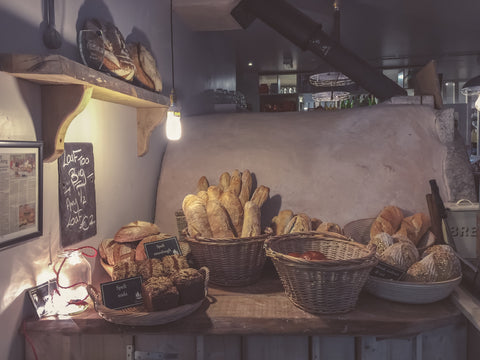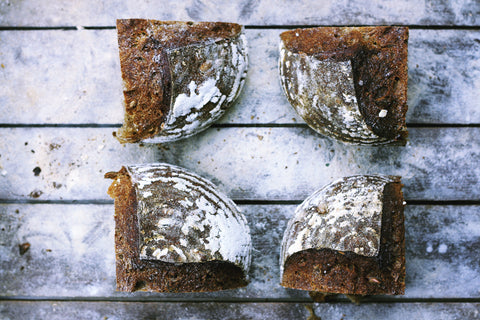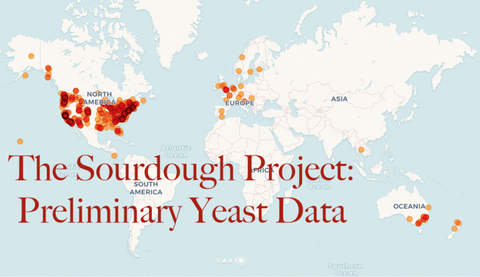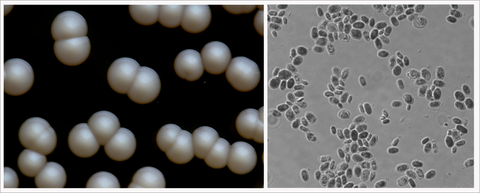Microbes under the Microscope: Sourdough
Sourdough, a kind of bread produced by natural fermentation, owes its flavor and health benefits to natural microbes.
Recently a public science project entitled "The Sourdough Project" shed more light on the complex relationship between microbes and bread by putting them under the microscope.

A Sourdough Starter
Unlike other breads, sourdough bread is different from other breads due to the absence of commercial baker's yeast to make it rise.
Instead, the dough (typically a base of flour and water) is fermented by the action of natural microbes. These microbes are introduced to the dough via a set of starter cultures called a "mother."
This starter typically contains both wild yeasts and naturally occurring lactic acid bacteria, which can be nurtured for many years (sometimes over a hundred!) by feeding the cultures flour and water and maintaining them at a constant temperature (68-70°F).
Since refrigeration slows the activity of microbes (though too much cold can kill them!), many bread starters are stored in the cool then warmed before use to reactivate the microbial communities inside. A portion of the mother is then mixed with flour and water to start the bread-making process.

Microbes in Sourdough
Sourdough bread most commonly uses lactobacillus cultures, a kind of lactic acid bacteria, which lend the bread its notable sour flavor.
These bacteria thrive in acidic environments, producing lactic acid in response to the conversion of available carbohydrates (i.e. flour) into the sugars they need to survive. Carbon dioxide, a bi-product of the fermentation process in these and other sourdough microbes, helps the dough to rise and give it its structure.
Sourdough starters can also comprise a range of other natural microbes such as airborne yeasts and microfungi. Together these microbes form communities who convert grains and water into a highly digestible, nutritious dough.

The Sourdough Project
Intrigued to learn more about the microbial communities employed in sourdough making, a group of scientists at North Carolina State University invited bakers from around the world in 2017 to submit samples of sourdough starters to study under the microscope. The researchers have also been studying microbes in other fermented foods including cheese, sauerkraut and kimchi.
Their aim with the Sourdough Project was also to study how the environment and different flours play a role in shaping the microbial makeup of different starters as well as how these factors may influence flavor, texture and the look of the finished loaf.
To do that, Benjamin Wolfe and his team of scientists at Tufts University grew and sequenced the DNA from collections of microbes from one hundred of the most diverse submitted starters to learn more about their characteristics. They also worked in situ with bakers in Belgium and from Denmark.
Sourdough Project Results
In total, over 500 people from across the globe submitted sourdough starter samples to the Sourdough Project. The results were released at the end of 2017.
Most sourdough starters contained a range of both fungi (carbon dioxide producing) and bacteria (acid producing), with the range shown on this map. However Lactobacillus brevis dominated the bacterial samples.
In total, the results show complex relationships and wide microbial diversity in global sourdough starters. While this is an evolving scientific field, this diversity is thought to explain the level of variation in finished sourdough breads.
Yeast Map
The results also indicated a wide range of yeasts, catalogued in this interactive map, made up much of the sourdough starters' microbial landscape.
Perhaps unsurprisingly a common form of yeast, Saccharomyces_cerevisiae (baker's yeast) was in abundance in people's homemade starters.
However the results also showed a wide diversity of other natural yeasts including: Saccharomyces servazzii (carbon dioxide producing), Saccharomyces unisporus (found in more liquid and warm starters), Pichia anomala, Saccharomyces castellii, Candida humilis, Saccharomyces bulderi, Saccharomyces exiguus, Kazachstania barnettii, Saccharomyces naganishii and Saccharomyces uvarum.
Interestingly, some of these microbes aren't able to utilize maltose, a sugar produced in the breakdown of starch in grains. Instead, they form partnerships with other microbes in the starter colonies to convert their bi-products into a useful energy source. This shows the adaptable nature of microbe colonies working in synergy to thrive and colonize a given food source.
In addition, many of these microbes can be found in other food sources including other fermented foods and beverages as well as natural surfaces (such as soil) from as far afield as America, Holland and Japan.
The results showed that sourdoughs are very much influenced by their environment as much as who (and what) they come into contact with!
These results were an exciting step towards a great understanding the microbial diversity of many common and healthy foods, which is an evolving science and business. For those interested in following the team's work across sourdough and other projects, more information can be found on the team's Facebook page.
---
Explore microbes and their relationship to our food and health in the eatCultured blog.
Sample the world's first organic coffee crafted with natural microbes to be healthier and more flavorful! Discover Cultured Coffee now.






1 comment
I world like to know of ácid lactic bacteria can produce carbon dioxide in volume ? Or if it is result of the yeasts?
During the process to put it in refrigerator around 46F after a week the sourdough is active even on refrigerator
The CO2 is a product of yeasts or bateria at this temperature ?